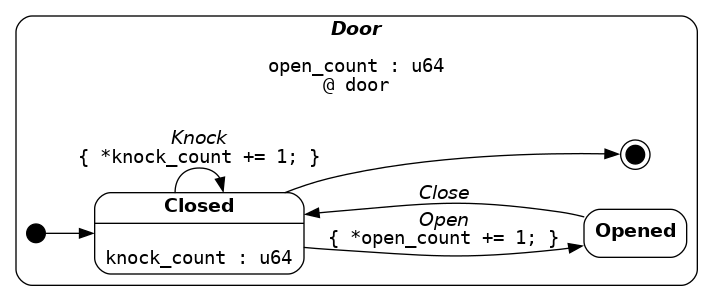Crate macro_machines
source ·Expand description
State machine macros with logging and graphviz DOT file generation.
An example that shows a number of features of the macro syntax is a Door
state machine with:
- two states:
Closed(with state-local variableknock_countand an exit action) and a simple stateOpen(with no state variables or actions) - three events: one internal event
Knock(with action on theClosedstate) and two external eventsOpen(with associated action) andClose(without any action) - an extended state variable
open_count– this variable is initialized once and is independent of the current machine state
def_machine_debug! {
Door (open_count : u64) @ door {
STATES [
state Closed (knock_count : u64) {
exit {
println!("knock count: {}", knock_count);
println!("open count: {}", open_count);
}
}
state Opened ()
]
EVENTS [
event Knock <Closed> () { knock_count } => { *knock_count += 1; }
event Open <Closed> => <Opened> () {} => { *open_count += 1; }
event Close <Opened> => <Closed> ()
]
initial_state: Closed {
initial_action: {
println!("hello");
println!("open_count: {:?}", door.as_ref().open_count);
}
}
terminal_state: Closed {
terminate_success: {
println!("open_count: {:?}", door.as_ref().open_count);
println!("goodbye")
}
terminate_failure: {
panic!("door was left: {:?}", door.state())
}
}
}
}
Within state entry and exit action blocks all extended state and local state variables are in scope.
In event actions, mutable references to extended state variables will
implicitly be brought into scope of the associated action block, however
local state variables need to be explicitly listed in the LHS brace of the
action construct to be accessible (e.g. the knock_count local state
variable in the Knock event action of the current example).
When making a universal or external transition, first state exit actions are performed, followed by event actions, and then after initializing the new state, state entry actions.
To make the state machine accessible in initial and terminal action blocks,
the macro implementation requires an identifier be introduced, door,
following the @ symbol. This variable is then brought into scope as an
alias for a mutable self-reference in initial and terminal action blocks.
Initial and terminal actions are always before and after any state entry and exit actions, respectively.
The Door::dotfile() function will generate a ‘.dot’ file string that can
be saved and rendered as a PNG with layout generated by graphviz dot tool:
$ dot -Tpng door.dot > door.png

Re-exports
pub extern crate log;
Modules
- Example generated state machine
Macros
- State machines with a default
initialstate. - State machines with a default
initialstate and derivingDebug. - State machine that requires runtime initialization.
- State machine that requires runtime initialization and deriving
Debug.
Enums
- Describes an exceptional result when attempting to handle an event.
Traits
- Methods for DOT file creation